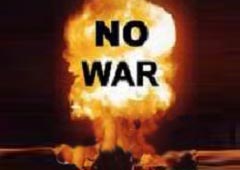It is a bizarre, exiled Iranian opposition group that has existed mostly on the fringes of history. But the cultish Mujahedin-e Khalq (MEK), or "people’s holy warriors", will seize the international spotlight if the US State Department decides in coming weeks to remove the group from its list of foreign terrorist organisations.![]()
The well-funded organisation, once allied to Saddam Hussein, has friends in high places in Washington.
Removing the MEK from the US’s terrorism blacklist would make already frosty relations between Tehran and Washington even icier.
It also "would allow the Mujahedin to receive US funding and become a powerful force in support of war with Iran, just like the Iraqi exiles who deceived us into war with Iraq did," Trita Parsi, president of the National Iranian American Council (NIAC), warned last week.
Iran’s domestic opposition meanwhile insists that lifting the MEK’s terrorist designation would spell disaster for the Green Movement. [..]
The MEK, dedicated to overthrowing Iran’s Islamic regime and considered a terrorist group by Iran as well as the US, is despised by ordinary Iranians because it fought alongside Saddam’s forces in the 1980-88 Iraq-Iran war.
In response to an MEK lawsuit, a US federal court last year ordered the State Department to review the group’s terrorist designation.
Hillary Clinton, the US secretary of state, is due to announce her decision next month. The MEK was blacklisted as a terrorist organisation in 1997 by her husband’s administration.
The group, however, has been taken off similar terrorism lists by the European Union after court decisions found no evidence of terrorist activity in recent years.
The MEK is led by the husband-and-wife team of Massoud and Maryam Rajavi. The latter, touted by the MEK as Iran’s "president-in-waiting", lives in suburban Paris.
Her spouse is a spectral figure who has not appeared in public for years. His whereabouts are unknown, although informed speculation suggests that he spends most of his time at Camp Ashraf, the MEK’s main base, a sprawling, mini-state within a state 65 kilometres north of Baghdad.
The MEK was founded in 1965 as an urban guerilla movement opposed to the US-backed Shah and played a key role in the 1979 Islamic revolution. Its ideology was a blend of revolutionary Islam and Marxism.
The MEK vehemently opposed US involvement in Iran and the State Department links the organisation to the deaths of at least six Americans in Iran during the 1970s.
The MEK also backed the takeover of the US embassy in Tehran in November 1979. When the hostages were freed 444 days later, the MEK berated the regime for "capitulating to imperialism".
But the MEK soon broke with the late Ayatollah Khomeini in a violent power struggle and was forced underground in 1981 when thousands of MEK members were arrested and many hanged. Most of its senior leaders fled to France. Another wave of executions followed in 1988.
But the MEK also got in punishing blows, assassinating scores of regime officials. The right arm of Iran’s supreme leader, Ayatollah Ali Khamenei, remains partially paralysed from an MEK bomb attack in 1981.
In 1986, under pressure from France, the MEK relocated to Iraq, where Saddam armed and funded it. Its main base there was Camp Ashraf, conveniently located 50 miles from the Iranian border for attacks against the Islamic republic.
But in 2003 the MEK suffered a devastating blow when Saddam was toppled by the US-led invasion. American forces stripped the group of its tanks and heavy weaponry but accorded its members "protected person" status.
About 3,400 Iranian former rebel fighters, many of them women, have since lived a limbo-like and precarious existence at Camp Ashraf.
Their plight made headlines in early April when Iraqi troops raided the camp, leaving at least 34 residents dead, according to a UN investigation. The MEK is strongly disliked by Iraq’s Shiite-led government, which is on good terms with Iran.
Many rights activists describe the MEK as a cult whose leaders have brainwashed members and dictate every aspect of their lives.
Former members paint a grim picture of life in Camp Ashraf, most of whose inhabitants are said to be middle-aged.
Massoud Khodabandeh, a former senior high-ranking MEK member, said: "People aren’t allowed to get married. Some there haven’t heard or seen a child for 25 years. There are no phones, no internet, no postal services, nothing.."
Mr Khodabandeh runs an organisation helping those trying to quit the MEK, and believes many at Camp Ashraf want to leave but are effectively held hostage by the Rajavis.
"Those caught trying to run away get severely punished," he said in a telephone interview from Leeds, England, on Sunday.
One of the most detailed studies of the MEK was conducted in 2005 by Human Rights Watch (HRW), the US-based watchdog.
Outlandish practices ordered by the Rajavis included "divorce by decree of married couples, regular writings of self-criticism reports, renunciation of sexuality, and absolute mental and physical dedication to the leadership," HRW said.
Its report focused on cases of would-be defectors being tortured at Camp Ashraf, including two who died under interrogation.
Yet the MEK has powerful supporters in Washington and European capitals.
Among the MEK’s heavyweight cheerleaders in the US are Jim Jones, President Barack Obama’s former national security adviser, Dennis Blair, the former director of national intelligence, and James Woolsey, who headed the Central Intelligence Agency.
Iran specialists are baffled by the vocal backing the MEK enjoys among some heavy-hitters in Washington. Gary Sick, an Iran expert at Columbia University in New York, said: "Their [the MEK’s] support inside Iran is very, very limited.
"The fact that they’re against the government in Iran doesn’t make them good," he added in a recent telephone interview. "The only thing that I can think of that would be worse than the present government of Iran is a government of the MEK."
Michael Theodoulou (Foreign Correspondent)

